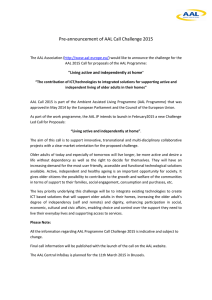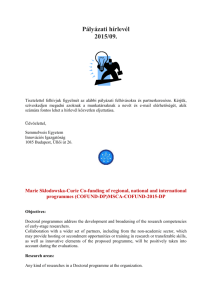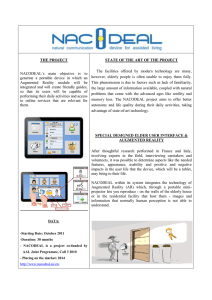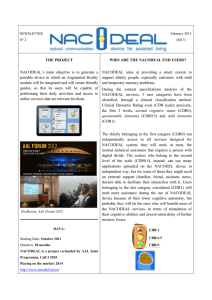The AALIANCE Roadmap p
advertisement
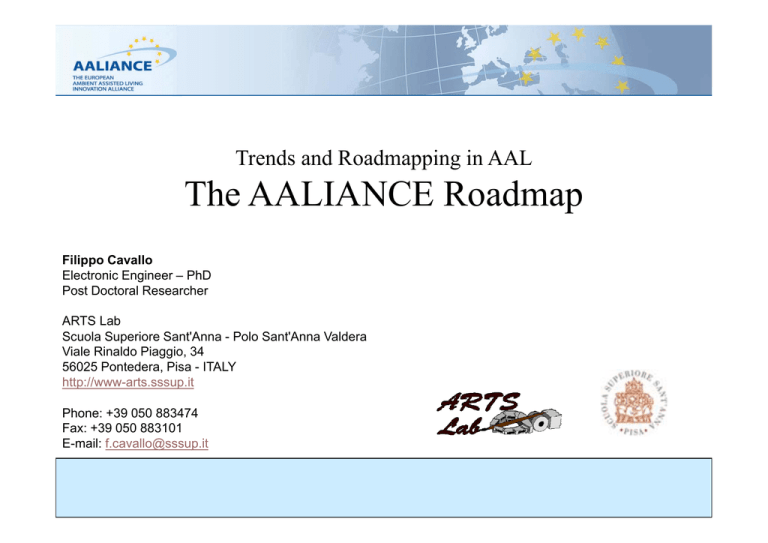
Trends and Roadmapping in AAL The AALIANCE Roadmapp Filippo Cavallo El t i E Electronic Engineer i – PhD Post Doctoral Researcher ARTS Lab S Scuola l S Superiore i S Sant'Anna t'A - Polo P l S Sant'Anna t'A Valdera V ld Viale Rinaldo Piaggio, 34 56025 Pontedera, Pisa - ITALY http://www-arts.sssup.it Phone: +39 050 883474 Fax: +39 050 883101 E-mail: f.cavallo@sssup.it Outline Background AALIANCE project Roadmap and trend Main domains E bli Technologies Enabling T h l i Conclusions Outline Background AALIANCE project Roadmap and trend Main domains Enabling Technologies Conclusions Background New European population projections has recently underlined that the number of elderly persons will quickly increase*. The fiscal impact of ageing will be substantial in almost all European Member States through two main channels channels**:: Pension (public expenditure increase up to 5% GDP) Health care and long-term care (public expenditure increase up to 1.5% GDP) * European population projections for 2008-2060, published by the European Office for Statistics. ** Report on the impact of ageing populations on public spending”, Council of the European Union, 2006. Aging population scenario A growing number of older people living alone and in need of (intensive) care. An ageing workforce. workforce A rapid growth in the number of persons with physical disabilities. More financially well-appointed and wealthy senior citizens ready to enjoy their third age and to spend money on products securing and enhancing wealth, safety, security and not forgetting entertainment and communications needs. ICT-enabled assisted living ICT-enabled assisted living and innovative technological developments can really provide aims and improvements: Quality of life, autonomy, participation in social life, skills and the employability of older people. people Home assistance for Patients. Caregivers. Domiciliary assistance for slowing down the course of the illness (not early hospitalization). p ) Reduction of welfare costs (nursing home costs three time the domiciliary one). Outline Background AALIANCE project Roadmap and trend Main domains Enabling Technologies Conclusions AALIANCE Project FACTS on AALIANCE - The European Ambient Assisted Living Innovation Alliance FP7 Coordination action (CA) THEME ICT-1-7.1 ICT and Aging Duration: 01/2008 – 12/2009 Partners: 14 Volume: 1.646.170 1 646 170 € EC Contribution: 1.070.000 € WP2 - Scuola Superiore Sant Sant’Anna Anna, Pisa AAL Roadmap published AAL Strategic Research Agenda h // http://www.aaliance.eu/public/documents/aaliance-roadmap/ li / bli /d / li d / Partners Outline Background AALIANCE project Roadmap and trend Main domains Enabling Technologies Conclusions Ambient Assisted Living context “Ambient Assisted Living” (AAL) denotes concepts, products and services that interlink and improve new technologies and social systems, with the aim of enhancing h i the th quality lit off life lif for f all ll people l in i all ll stages t off their th i lives. li AAL could be best translated as “intelligent intelligent systems of a specific assistance for a better and safer life in the home environment”. More in AAL Surrounding Social activity S i l Interaction Social I i Hobbies Inclusion Work ability Mobility Learning Dependency from: Habits Life style Needs Pathologies g Evolution of illness Psycho-Social conditions Primary Stakeholders Tertiary Stakeholders -Users U -Caregivers - Organization O i ti supplying l i goods d andd services i Users Secondary Stakeholders Quaternary Stakeholders -Organization offering services - Organization analyzing the economical and legal context of AAL AAL domains and technologies AAL application domains • • • @ home/mobile (person-centric) Main functions and enabling technologies Sensing Health rehabilitation, Health, rehabilitation care Safety and security New sensors Activity management / cognitive support Sensor networks Autonomyy / physical p y support pp Person-centric services @ community Mobilityy Social Inclusion Entertainment and Leisure @ work Collaboration, cooperation Presence/process awareness Aware and ubiquitous workplaces Reasoning Ontologies Event stream processing Probabilistic reasoning Acting New actuators Home robots and mechatronic devices Interacting Multimodal, natural, persuasive interfaces C Communicating i i New protocols and standards for communication network From Domotics to Ambient Intelligence (AmI) to Ambient Assisted Living (AAL): evolution driven by technology convergence • Digital CONVERGENCE in communications market (mobile + iDTV + Broadband Internet) enable UBIQUITOUS ACCESS • CONVERGENCE in home and environment control technologies enable AWARENESS • Distributed embedded intelligence (software agents) • Open O standards t d d for f home h automation t ti (KNX, (KNX UPnP,…) UP P ) • Emerging standards for low-power wireless communication (ZigBee, BT) • • CONVERGENCE between AAL technologies and Robotic Technologies enable UBIQUITOUS ROBOTICS FOR AUTONOMY NEW APPLICATIONS AND SERVICES (tele-monitoring, care and -rehabilitation, cognitive support to daily living, …)) Tele-rehabilitation eGov’t, eCommerce UbiRob-supported cognitive autonomy Tele-monitoring Tele care Tele-care Biorobotics Ubiquitous robotics Biorobotics for care, h lth and health d autonomy t Tele-medicine Aware Home technologies distributed intelligence g Software agents smart home Events stream processing Ambient intelligence BAN - Wearable sensing and computing multi-standard connectivity Mobile communication Interactive DTV Broadband connectivity Outline Background AALIANCE project Roadmap and trends Main domains Enabling Technologies Conclusions The domains in AAL AAL4Person Ageing well (@home, @mobile) PERSONAL AUTONOMY AND WELL-BEING AAL in the Community Ageing well in one’s social environment PARTICIPATION AAL@W k AAL@Work Ageing well in one’s working environment ACTIVE AND PRODUCTIVE AGEING AAL for persons (at home, on the move) Health, rehabilitation and care Personal and home safety and security P Personal l activity i i management Biorobotic systems and AAL Person-centred services AAL4persons: Health, Rehab, Care Person-centered health management Tele-monitoring and self-management of chronic diseases Tele monitoring of health parameters – sensors and connectivity Tele-monitoring Wearable and implantable multisensor platforms – power management Support for caregivers and care providers Teleconsultation, from A/V to tele-presence + 3D A.R. Vital data acquisition and transmission Remote actuators AAL4persons: Personal and home safety and security Safety/security against external threats Distributed sensor networks & service centres, self-configuration Safety against falls and other accidents Wearable and mixed environment/wearable sensors; integration vision + inertial + localization (indoor/outdoor) + situation interpretation; implantable sensors, integration with smart orthoses (new materials) Personal activity management sensors and systems for indoor localization and monitoring; ontologies and user models - activity models for activity recognition and monitoring and for cognitive support; ubiquitous audio-video-data communication; multi-channel u t c a e stimulation; st u at o ; ubiquitous/pervasive sensing and computing + pervasive communication = Internet of Things; event streams processing and probabilistic reasoning. reasoning AAL4persons: Biorobotic systems and AAL AAL4persons: Biorobotic systems and AAL AAL4persons: Person-centred services New generation technologies and technology enabled services for: Shopping Feeding Remote shopping, “missing product” services, assisted shopping in the shop environment (smart shopping cart and shelves, ...) Smart cookers, lids and pots and pans, with sensors Smart meal cooking and delivery services Assisted feeding and drinking devices Personal care Self health management Autonomous dressing/undressing Personal hygiene + safety in the restroom AAL in the communityy Social inclusion Entertainment and leisure Mobility AAL in the community: Social inclusion Participation in the community life Accessing g information Physical access to services and activities increasing remote access to events and services; developing local mobility networks of minibuses which move the elderly and disabled from their homes to the location of services and events; designing systems that move individuals autonomously to the desired location Creativity, hobbies, sports Cultural and experience exchange AAL in the community: Entertainment and leisure Commercial/Augmented thought-provoking games Vi t l navigation Virtual i ti tests t t andd exercises i Executive functions tests and exercises Augmented toys Interrealityy games g Augmented Reality games T h l Technology convergence andd effect ff t on researchh AAL in the community: Entertainment and leisure Cognitive sciences “Internet of things” objects have a digital identity and intelligence Advanced Computer games Single function Single-function brain training games TODAY TODAY research commercial Interreality (Pervasive & AR) Games real-world objects into the game “ecological” ecological games embedding Cognitive training 3R (Reality orientation, Reminiscence, Remotivation), Occupational Therapy cognitive training and assessment embedded (as a game) in everyday life through interreality y Mid/Long term research TODAY research AAL in the community: Mobility Supporting pedestrian mobility; Public transport Biorobotic systems for mobility support 4G mobile telephony, telephony From satellite to ubiquitous (indoor and outdoor) geolocalisation, Advanced web-based services and digital mapping, Near-field communication and wireless sensor networks use of web-based technologies to supply on-trip information in a variety of formats at h home, t mobile to bil devices, d i in i vehicles, hi l att stations, t ti etc. t Ambient-Assisted Driving Priority of vehicle-based autonomous systems: ESP (Electronic Stability Program); blind-spot monitoring; adaptive head lights; obstacle & collision warning; P i it off infrastructure-related Priority i f t t l t d systems: t eCall; extended environmental information; RTTI (Real-time Travel and Traffic Information); dynamic traffic management; local danger warning; speed alert. AAL at work Workplace accessibility and comfort Active support to work tasks y and health @ work Safety AAL@work: Workplace accessibility and comfort Active ergonomy: individual and shared workplaces are selfconfigurable, g , based on workers’ pphysical y and sensorial characteristics and to their preferences Dynamic, self-adapting and configuring HMI/HCI Smart environments interacting with biorobotic support to mobility (wheelchairs and beyond) AAL@work: Active support to working tasks Robotic co co-workers workers -> > biorobotics 4 Autonomy/QoL Task monitoring and cognitive support Simpler than @home: working tasks are usually more structured than everyday life tasks Work planning support (smart agenda, integrated with AAL environments and “dust” intelligence) AAL@work: safety and health at work Ubiquitous sensing + accurate models for safer worker-machine interaction Combined monitoring of physiological and environmental parameters t for f health h lth In case of exposition to chemical agents In case of chronic conditions or other risk factors (cardiopulmonary, metabolic, musculo-skeletal) Stress level l l monitoring i i andd proactive i reduction d i AA d i i AA-driving Outline Background AALIANCE project Roadmap and trends Main domains Enabling Technologies Conclusions Enabling technologies and functions 1. 2. 3. 4. 5. htt // http://www.aaliance.eu li Sensingg Reasoning Acting Interacting Communicating Sensing (1) In AAL applications, sensing is expected to take place in anything and anywhere: in- or on-body, in- or on- appliances or in the environment (home, outdoors, in vehicles public spaces, vehicles, spaces etc.). etc ) In AAL it is better to refer to “smart smart sensor sensor”. 1) MEMS-based miniaturized and low-cost sensor. 2) DNA-sensors for measuring genetic diseases and/or genetically modified food. 3) Sensor communication systems based on advanced mobile communication protocols. 4) MEMS sensors for food and health care applications. 5) Miniaturized energy supplies for integration in self-contained sensors. 6) Lab-on-a-chip sensing (e. g. capillary separation and optical detection). 7) Motion-control and collision-avoidance (microwave sensors). 8) Ultra-small biosensors with implanted components in medical or other applications. 9) Biosensors for various applications. 10) MEMS devices based on polymer materials. Sensing (2) Short term (2013) Mid term (2020) Long term (2025) Seensors •Heartbeat Heartbeat Detection – ultra ultra-sensitive sensitive accelerometers •Non-invasive peripheral neural interfaces •Internet-connected sensors and actuators – SODA, Mulle3 etc •Universal Positioning – Galileo / GPS / MPS / WLAN / UWB / signal i l space trilateration t il t ti •Location technologies for in-door navigation •Sensors for indoor localization •Adaptive sensors and actuators •Item identification – RFID (standalone, bracelet-worn), NFC, BT, ShotCode •Super low power sensors •Sensors for human state detection •Invasive Invasive peripheral neural interfaces •Non-invasive cortical interfaces •Camera with object detection, classification and recognition •End-to-end, close-loop systems from sensors, actuators t t andd data d t analysis l i •Biologically Biologically human inspired sensors •Biologically inspired sensor-actuator integration Pro ocessing •Advanced signals and image processing for detection •Algorithms for better signal filtering •Advanced methods for position detection of persons; •Video-motion analysis •Video-motion prediction •Context Acquisition q and Use •Valid and reliable techniques for the specific physiological signal; •Advanced pattern recognition •Sensor data aggregation and fusion from different sensors •Reliable classification of relevant situations from sensor signals and context information Poweer •Energy scavenging and management •Endless power to mobile sensors, actuators and processors (wireless/battery) Reasoning (1) A core function of AAL systems is the conclusion of knowledge about the activities of the user and the current situation in this environment from low-level sensor data (d il activities (daily i i i and d situations, i i emergency situations, i i user’s ’ mid-term id and d long-term l behavior). Sensor fusion aspects. Emergency situations: E i i 1) Helplessness/lying on the floor 2) Indicators of falls 3) Motionlessness 4) Critical C i i l values l i vital in i l parameters. Activities of daily living: 1) Sleeping 2) Toilet T il usage 3) Personal hygiene 4) Preparation of meals. Psychosocial P h i l behavior: b h i 1) Going out 2) Meeting people 3) Communication. Motion: 1) 2) 3) Occupancy of rooms Locomotion Quality and quantity of motion. Vital parameters: 1) Pulse rate 2) Respiration rate 3) Blood pressure 4) Body weight. Reasoning (2) Acting (1) - Rehabilitation Mechatronic technologies for AAL, including operative robot, wearable robot for rehabilitation and assistive purposes. T h l i l changes: Technological h Human musculoskeletal actuators (artificial muscles) Models for control Acting (2) – Robotic interaction Neural Machine interfaces for actuating mechatronic devices Invasive methods (cortex, spinal cord, peripheral nerves, muscles, etc…) Non Invasive methods (needles, cuff in tissues, etc…) Surface methods (EMG, EEG, etc…) Technological changes: Brain Computer Interface (BCI) Acting (3) – Internet-connected sensor and actuators The integration of sensors and the Internet presents some issues that can fully exploit the capabilities of WSNs. Pervasive distribution of intelligence and sensing throughout the home environment Technological changes: Internet of Things Acting (4) – Robotic appliances Personal robots are being investigated also as robotic appliances. Acting (5) – Companion robot Adaptive Robotic Servant in Intelligent Homes. Objectives in this application area are identified as: time saving in daily repetitive work; having a companion and a servant/assistant; personal pe so a robots obots adaptat adaptation o to individual d v dua needs; eeds; exercising robots; medical support; reaching hi high hi h acceptance t by b inexperienced i i d users; 24-hour service in household environments; robots in environments dangerous to humans; mobility; incremental development of robots. Interacting Human beings and machines will be surrounded by intelligent interfaces supported by computing and networking technology in everyday objects. Timeline Topic 2010-2015 Common generic interface standards. Toolkits. Living labs. User initiative, adaptable interfaces Local (touch) screen-based Context-awareness of predefined factors Standalone products (including mobile phones) 2015-2020 Mixed initiative,, self-adaptive p interfaces Rich interaction through distributed objects. Gestures. Learning Products networked inside home 2020-2025 Avatar robots, brain-computer interfaces Social + emotional awareness Communicating (1) In AAL System infrastructures are becoming pervasive, with an increasing number of distributed devices that can communicate between themselves as well as with centralized li d services. i Network Context Public area D Domotics ti Local or home P Personal l or body b d Connectivity and protocols Data Exchange Understanding data Dynamic composition of systems and services Communicating (2) Internet of Things Service Era 2010 - 2030 Internet of People Communication Era 1900 - 2010 Internet of Presence Virtual Presence Era 2030 Outline Background AALIANCE project Roadmap and trends Main domains E bli Technologies Enabling T h l i Concl sions Conclusions Conclusions Necessity to: Cooperation C i and d synergies i between b research h organizations, i i end-user d organizations and industries for an excellent development of products and services. Provide a framework for stakeholders, led by industry, in order to define research and development priorities Improve the collaboration within the AAL value chain in Europe Reinforce the position of European providers of AAL solutions in a global context Work with ith primary users: patients and caregivers caregi ers to focus foc s on real needs. needs Funds and investment for innovation. Next step: a Strategic Research Agenda for AAL in Europe Future Scenarios and Products identification Roadmapping enabling technologies, products and scenarios, identifying challenges SRA EU policies and strategic objectives Prioritizing challenges A comprehensive action plan g challenges g in the addressing framework of the existing EU instruments for Research and Innovation support (FP7, AAL JP, ICT PSP) ICT-PSP) End Questions? Filippo Cavallo Electronic Engineer – PhD Post Doctoral Researcher ARTS Lab Scuola Superiore Sant'Anna Sant Anna - Polo Sant Sant'Anna Anna Valdera Viale Rinaldo Piaggio, 34 56025 Pontedera, Pisa - ITALY http://www-arts.sssup.it Phone: +39 050 883474 Fax: +39 050 883101 E-mail: f.cavallo@sssup.it **************************************************************************
